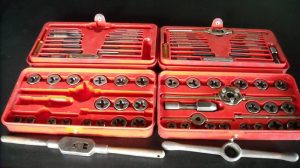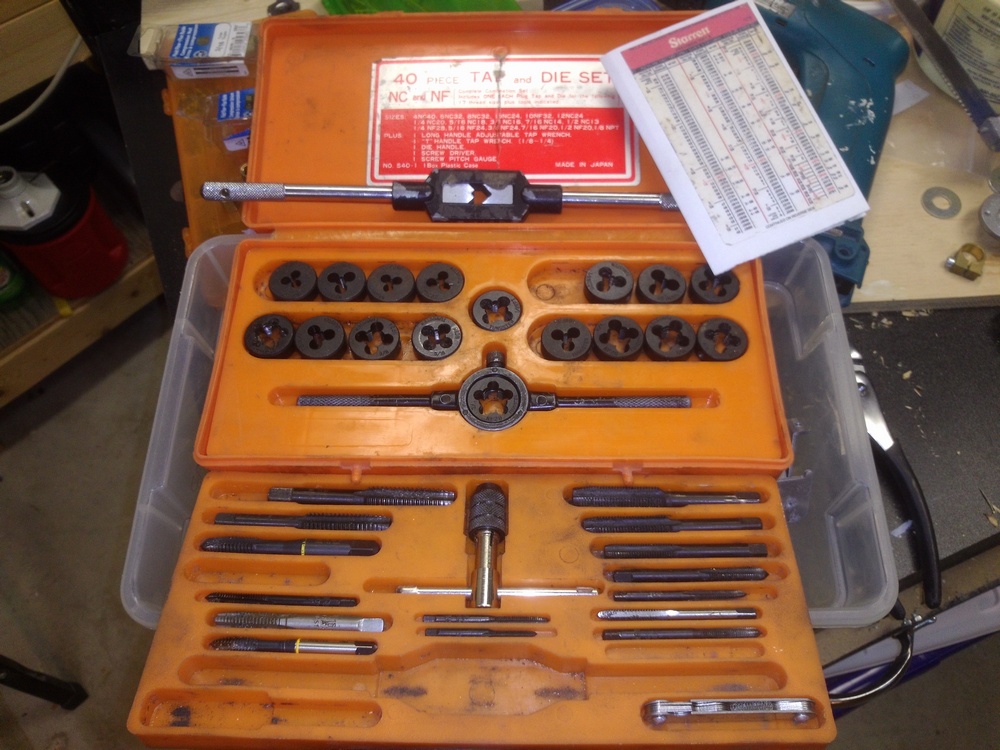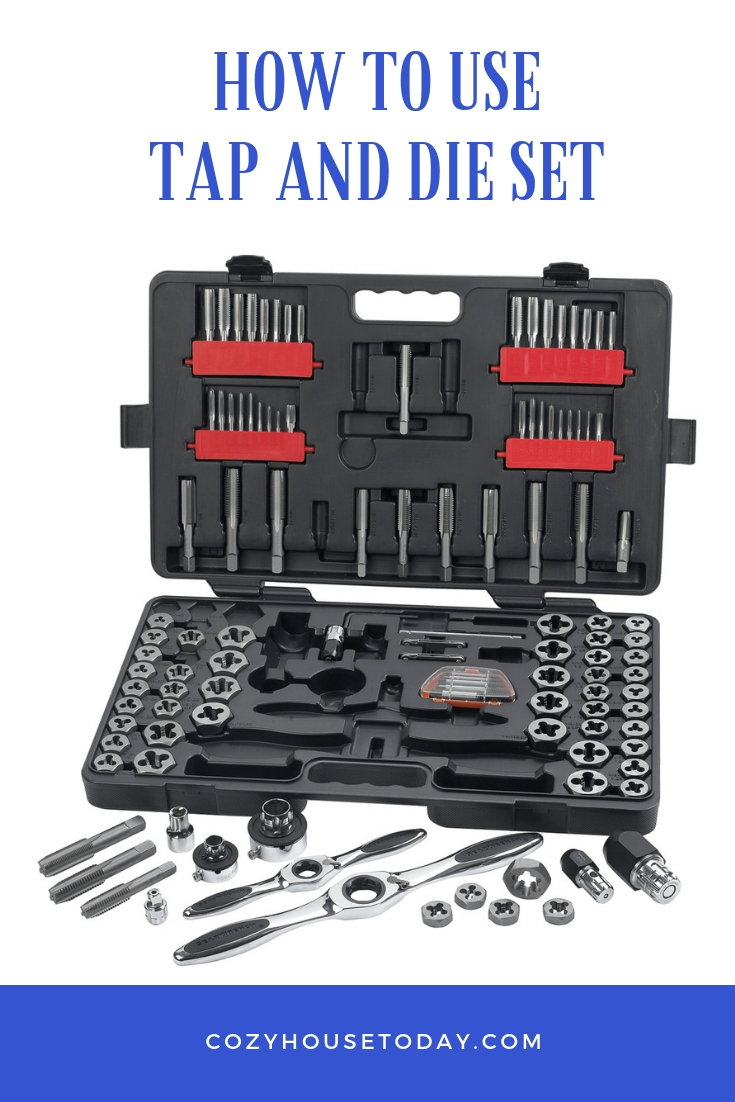how to use tap and die
 Do you have a broken bolt or screw that you need to remove?
Do you have a broken bolt or screw that you need to remove?
Are you trying to hang a painting, repair a vehicle or lawnmower engine, or complete a do-it-yourself project in your home and you need to create or repair threads?
If these are issues that you face, you will need to learn how to use a tap and die set.
While the concept may seem overwhelming at first, especially if you are not particularly good with your hands, it is a skill that can easily be acquired with a bit of patience and lots of practice.
First, you must know what these tools do, and the difference between the two. Taps are tools that create threads within a material, and dies are tools that create threads on the outside of a material.
Taps and dies may seem complicated to work with at first, but they are not as complex as they appear to be. After all, I, too, was green when I first bought my set, but it was quite simple for me to learn how to work with it on my own.
It is so very important to have this knowledge because you never know when you may need to create threads.
For example, you may be fixing a plumbing leak and need to make a new pipe, or you may be building your son and daughter a tree house and you accidentally strip a couple of bolts.
In nerve-wracking times like these, a working knowledge of tap and die sets can come in handy!
Materials Needed to Follow this Tutorial
It is always important that you have all your materials ready and available in advance. This will ensure that the process goes smoothly and you won't have to stop and search for a critical component in the middle of working.
It is always best to have everything prepared and in front of you ahead of time when you are starting any type of project that requires a wealth of materials.

You may have thought that all you needed was a good tap and die set, but you will actually need additional materials in order to properly cut threads on the inside and outside of a given object.
Here is everything you will need before you get started:
- A fully stocked tap and die set, with taps and dies in several different sizes to accommodate the many different jobs that you may need to use them for
- The tap or die in the appropriate size to create the threads or cuts that you need
- The material that you wish to thread or cut on the outside or inside
- A drill (for tapping only) – this is to create a hole in a material in which threads or cuts will be made. This is not necessary when you are using a die to make outside cuts and threads
- A vice or grip to hold the material steadily while you make the threads
- A ratchet to turn your tap into the hole in the material and a die wrench to turn your die around the material
- Cutting oil to soften and make more malleable hard materials such as cast iron, nickel, titanium, or steel
Using a Tap
Choose the Correct Drill Size for the Tap you Intend to Use
Most kits will come with a standard guide that will help you with this step. Follow the charts to see what is required.

Fasten the Material you will Cut Securely
Insert the intended material into your vice or clamp. Once the material is in a position where it can no longer move or slip, you are ready.
Start Drilling
When you begin to drilling the hole for your tap, start at as slow a speed as possible. Always apply cutting oil on harder surfaces to soften them up appropriately.

Start Tapping to Create Threads
Insert the tap and use the ratchet to slowly turn the tool. Turn the tap completely around in a clockwise manner two times, then backtrack half a turn.

This method prevents broken material from damaging the inside of your new thread while you work. Apply cutting oil as needed.
What Types of Taps Are There?
There are two classes of taps. This is a manual and power tap. Let's look at what types of taps are.
Hand Taps
There are two types of hand taps.
Taper tap. Taper tap is made in the form of a cone. This facilitates gradual tapping. This taps are most commonly used.
Bottoming tap. The bottoming tap has almost no cone at the end. It allows you to cut the thread to the bottom. Such bottoming taps are useful for making through holes. To do this, you first need to thread a large part of the hole with a taper tap, and thread the lower part with a bottoming tap.
Power taps
These types of taps availabel for machine or manual processing.
Spiral Point Taps. These threaded taps have a spiral thread with raised grooves. They look like most hand taps. But the front cutting edges have a helix angle. It helps push out chips.
They are more efficient and faster than manual taps.Point taps can be made in the form of a cone or a more direct shape with a smaller cone at the end.
Spiral Flute Taps. Spiral taps have an open spiral. They throw the chips up out of the hole. And they are well suited for blind holes.
Interrupted thread taps. These threaded taps have only a tooth for each other thread. This allows for better chip removal.
Pipe Taps. Pipe taps are used for threading pipes. There are straight and tapered bends for pipes.
Form Taps. Form taps do not cut threads. They allow you to compress the metal in the desired position, and not to thread it. No chips to remove. As a result, such a thread is more durable.
Form taps are suitable not only for soft materials, such as aluminum, for example. These are suitable for materials with hardness up to 36 HRC.
Extension or long shank taps. These are threaded taps with a long shank. Their shape gives more complete access to difficult openings.
Using a Die
Choose the Correct Sized Die for your Job
You can easily figure this out if your dies are arranged in the correct order. Just take the one that looks the most appropriate, and see if it fits. If it does not, then try a size larger or a size smaller until you get the right one.

Fasten the Material You will Cut Securely
Again, snugly fasten your intended-to-be-cut material using the vice.

File the Material
Be sure the end of the rod that you intend to thread is square.
Insert the Die into the Die Wrench and Begin Cutting
Apply some cutting oil and place the die over the material. Turn the wrench clockwise, and like the tap, make two full turns with a half a turn backwards.
How to Use Both Taps and Dies to Create Threads and Cuts:
I hope you enjoyed this easy tutorial on how to use a tap and die set. Please be sure to follow each step I outlined for your best results, even if they seem time-consuming.
You may think a step or process is unnecessary to the job you are doing, however I have found that everything that I listed is extremely important when it comes to the end result.
Remember, taking a shortcut can result in a job that does not go as planned, wasting materials and your valuable time. You may also sustain an injury in the course of your work if you skip a crucial phase. It is best to follow all instructions as they are provided.
If you enjoyed this article, please pass it along to your friends and family and share it on social media! Also, please let me know what you think by submitting a comment below!

how to use tap and die
Source: https://cozyhousetoday.com/garage/hand-tools/how-to-use-tap-and-die-set/
Posted by: paradawerve1992.blogspot.com

0 Response to "how to use tap and die"
Post a Comment